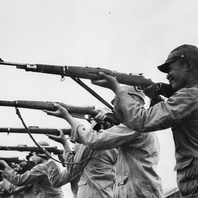
Item
RNG troops with rifles
Photograph of RNG army recruits engaged in rifle practice, possibly as part of the Rural Pacification (qingxiang) campaigns.
Read More
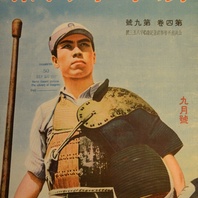
Item
Xin Zhonghua huabao (New China Pictorial) cover, September 1942
This cover image from the New China Pictorial 4.9 (September 1942) shows an unnamed member of the Chinese collaborationist forces in the outfit of a kendoka. There is little to identify this image (almost certainly created by the news agency Dōmei, as it was used as the cover image for the Japanese-language Dōmei Graph in October 1942) as being of a Chinese man, other than the inclusion of the Nationalist Chinese (white sun) insignia on his cap. The same image was used in later propaganda celebrating the collaborationist government’s declaration of war on the Allies. This was the only cover image from this magazine which included a male figure. The New China Pictorial was a bilingual (Chinese-English) published from 1939 through 1944 in Shanghai by the occupation journalist Wu Linzhi for distribution in China and throughout Southeast Asia.
Read More
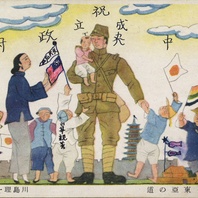
Item
Kagayaku Tōa no michi (The road to a shining East Asia)
This postcard, featuring an illustration by the prolific Japanese artist Riichiro Kawashima, shows a Japanese soldier celebrating “kagayaku Tōa no michi” (the road to a shining East Asia), with Chinese civilians. Of interest here is the fact that the Republican Chinese flag appears to have been drawn onto the postcard (and made to look as if it is being held by the child dressed in white), while other figures in the image hold the “five-coloured flag (wuseqi). The “five-coloured flag” was used by the Reformed Government of the Republic of China (RGROC) up until March 1940, but was replaced by the Republican Chinese flag with the formation of Wang Jingwei’s government. This suggests that the postcard was made prior to March 1940, but used some time thereafter. Text reading “qing zhu xin zhongyang zhengfu chengli” (Celebrating the founding of the new central government) has also been added above the figures, while the phrase “Ri-Hua qinshan” (Japanese-Chinese friendship) has been added to the boy in white.
Read More
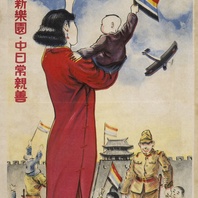
Item
Ertong xin leyuan, Zhong-Ri chang qinshan (New paradise for children; China and Japan will forever be close)
This poster, almost certainly produced with the aim of encouraging civilians in occupied Beijing to embrace Japanese rule, includes many of the standard tropes of early occupied north China propaganda: a “new woman” with a male child; city walls; Japanese soldiers fraternising with Chinese infants; the “five-coloured flag” (wuseqi); and a sky filled with Japanese airplanes.
Read More
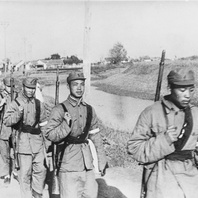
Item
RNG troops by a riverbank
A group of RNG soldiers walks along an unidentified river bank. Possibly part of the Rural Pacification (qingxiang) campaigns.
Read More
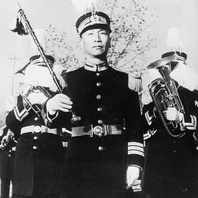
Item
Drum major
Photograph of an RNG brass band led by a drum major in front of the Executive Yuan in Japanese-occupied Nanjing. The “occupation state” put great store in military parades.
Read More
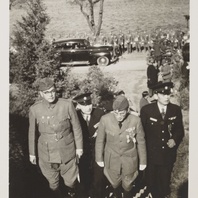
Item
Subhas Chandra Bose in Nanjing, November 1943
Lin Baisheng, RNG publicity minister (second from right) and Chu Minyi (second from left) accompany a uniformed Subhas Chandra Bose (far left) (leader of the Indian National Army) during his visit to Nanjing in November 1943. Both Wang Jingwei and Bose had attended the Greater East Asia Conference in Tokyo in the same month, and Bose’s visit to Nanjing was celebrated by an administration which had few opportunities to welcome prominent international leaders to its capital.
Read More
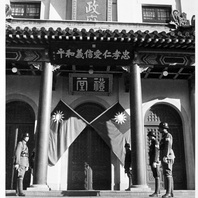
Item
Entrance to RNG Government Headquarters
Chinese and Japanese soldiers guard the entrance to the ceremonial hall (litang) of the national government compound in Nanjing in November 1940. Above the door is a plaque, written by the head of the (non-RNG) national government Lin Sen, which reads: “Loyalty, benevolence, righteousness and peace” (zhongxiao, ren’ai. xinyi, heping). Note that the “unadulterated” Nationalist Chinese flag (without the yellow pennant that the RNG had been forced to attach by the Japanese in spring 1940) is flown here.
Read More
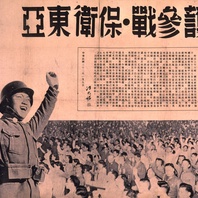
Item
Yonghu canzhan, baowei Dong Ya (Support the declaration of war; defend East Asia)
Poster of Chinese soldier celebrating the declaration of war on the Allies by RNG China. The poster reads “Yonghu canzhan, baowei Dong Ya” (Support the declaration of war; defend East Asia), and includes the text of Wang Jingwei’s declaration of war on the Allies on 9 January 1943. Note that some postwar owner of this poster has written “wei guomin zhengfu” (bogus National Government) to the right of the text by Wang Jingwei so as to clarify which Chinese administration was declaring war on this occasion.
Read More
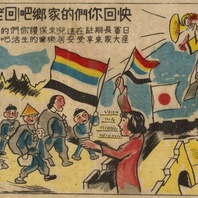
Item
Kuai hui nimen de jiaxiang ba! (Hurry back to your homes!)
This leaflet, produced with the aim of encouraging civilians in occupied north China to return to cities and towns under Japanese rule, includes many of the standard tropes of early occupied north China propaganda: a “new woman”; city walls; the “five-coloured flag” (wuseqi). The text on the leaflet reads: “Hurry back to your homes! Return to your hometowns! The Japanese army will be here for a long time. Come and protect your livelihoods and your assets. Everyone can savour living in peace and enjoying their work again”.
Read More
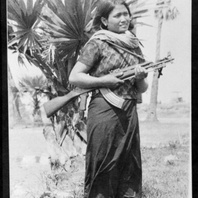
Featured Item
Female soldier of the Kampuchea United Front for National Salvation
This unattributed photograph shows a young Cambodian female soldier of the Kampuchea United Front for National Salvation (KUFNS, also known as FUNSK) [Front or Renakse]. She stands in front of a tree holding a rifle. She is not in uniform but wears a sarong (traditional lower garment). The image was featured in the publication (French and English versions) entitled The People’s Republic of Kampuchea (1979). This photograph is part of the collection held by the Agence Khmère de Presse (AKP) and Cambodia’s Ministry of Information. This collection, which documents the early years of the People’s Republic of Kampuchea as photographed by the Vietnamese and a small team of Cambodian photographers, has not yet been classified or indexed.